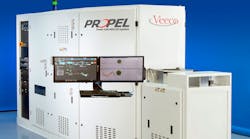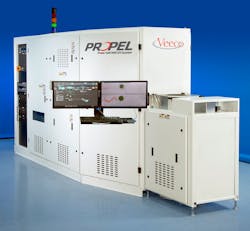Solving GaN-on-Si Integration Challenges in RF Applications
Gallium-nitride (GaN) market forecasts were pushed out in recent years because of integration and reliability issues. However, they are now experiencing a significant uptick due to continuing development and maturation of GaN device technology.
With these improvements, the RF industry’s need for high frequency, efficiency, and linearity within smaller form factors will no doubt create additional opportunities for GaN moving forward. 5G applications will transform cellular communications, creating new opportunities for wireless carriers and service providers. For military applications, GaN devices bring advantages in size, weight, power, and overall system cost (SWaP-C) for a multitude of platforms.
Why GaN?
GaN has the potential to overcome and outperform the limitations of materials such as silicon (Si), silicon carbide (SiC), gallium arsenide (GaAs), and indium phosphide (InP) in RF and power applications. Looking at the materials properties of GaN, it becomes apparent why GaN overcomes the physical limitations of other materials:
- Wide bandgap (3.4 eV): High-voltage operation, high critical electric field
- High electron velocity (2 × 107 cm/s): High switching speed
- High temperature capability: >150°C junction temperature
In the 5G arena, the high-speed network will offer greater than 10-Gb/s transmission speeds for mobile broadband (phones/tablets/laptops) and ultra-fast low latency for Internet of Things (IoT) applications (vehicle-to-everything, or V2X, communications). GaN is replacing Si in specific wireless applications (i.e., 4G/LTE base-station power amplifiers), and it will significantly impact next-generation 5G deployment because power amplifiers for all transmission cells in the network (macro, micro, pico, femto/home routers) will benefit from GaN advantages. Military applications, such as jammers, communications, and radar, benefit from improved bandwidth, efficiency, and power at higher operating frequencies.
GaN Challenges
The inherent materials advantages of GaN came with associated manufacturing challenges, including the cost and optimization of epitaxy and the optimization of device processing and packaging. Other issues include charge trapping and current collapse, which are being actively resolved by Veeco scientists independently as well as in collaboration with leading device companies and research institutes worldwide.
GaN-on-silicon (GaN-on-Si) is emerging as a front-runner in device performance and cost, as comparable or superior performance has been demonstrated relative to GaN-on-silicon-carbide (GaN-on-SiC). In addition, the overall cost structure, manufacturability, and supply-chain ecosystem provide advantages in producibility. The GaN-on-Si approach offers wafer sizes starting at 150 mm up to 300 mm, greatly improving the potential for reduced device cost through scaling.
GaN-on-Si technology starts with, and is enabled by, a state-of-the-art manufacturing approach for epitaxy using metal organic chemical vapor deposition (MOCVD). When the goal is to create a highly repeatable manufacturing process on large substrates that achieves high final device yield, batch systems no longer offer sufficient control compared to a single-wafer process approach.
Veeco’s Propel Power GaN MOCVD system, which features a single-wafer reactor platform, is capable of processing six- and eight-inch wafers.
Such a goal can be achieved by leveraging Veeco’s Propel MOCVD system, a single-wafer reactor (SWR) that provides superior film-deposition control (see figure). Thanks to the SWR’s capability to control the epitaxy process, it’s possible to meet tighter specifications (within wafer, wafer-to-wafer, run-to-run, and tool-to-tool) on larger substrate sizes in the following areas:
- Uniformity (thickness, composition, doping)
- Repeatability
- Particle defectivity
- Strain and wafer curvature control
- Interface abruptness
These epitaxial performance areas are needed to make significant inroads into GaN RF applications. Next-generation production systems using silicon substrates need to be adaptable to a wider process window and offer the highest throughput combined with the lowest cost of ownership. First, the epitaxy layers must be deposited with excellent uniformity across the wafer for both thickness and composition control to effectively incorporate buffer layers and super lattice structures.
Control of the stress in the wafer is also extremely important to achieve the desired material quality, buffer isolation, and RF loss on the silicon substrate. In addition, customers demand accurate dopant control with sharp interfaces across the wafer to optimize the device properties. There must be excellent uniformity and repeatability to effectively incorporate dopants such as carbon and iron to optimize doping levels across multiple runs. This becomes more challenging with larger substrate sizes, which is what Veeco’s Propel MOCVD system is designed and optimized to deliver the required performance.
Need for 200- and 300-mm GaN Innovation
Another important factor to consider is the demand for 200-mm GaN-on-Si. Cost is a major factor for the RF industry, and migration from 150-mm Si wafers to 200-mm Si will reduce the cost per die. But more importantly, the eight-inch fab infrastructure uniquely provides capabilities that are now critical as the industry is poised to ramp up mainstream adoption.
The ultimate goal for using GaN-on-Si is to scale to 300 mm, thereby reducing epitaxy cost per unit area, as well as the downstream processing cost, by leveraging the industry’s 300-mm infrastructure. Veeco has shipped a full-production 300-mm system, demonstrating process performance on 300-mm silicon wafers and data that proves scaling to be successful with results equal to or better than 200-mm wafers.
In summary, Veeco has developed the state-of-the-art in MOCVD technology for GaN-on-Si and is ready to support production ramps. By leveraging these epitaxial process improvements, large-area Si substrates, and unique advantages of single-wafer reactor processing, GaN will continue to advance RF system capabilities and applications.
Drew Hanser is VP of Technology at Veeco Instruments.


